As things are, bugging in vs bugging out is a lifestyle choice. Considerations such as a stockpile, underground bunker, medical supplies and a self-contained garden and animal food system can make the choice easy to bug in for survival.
Other reasons to stay put on a homestead rather than bug out, can be having elderly, younger, disabled or injured family members or a big one: this is your family’s land and it has sentimental value and you are not going anywhere.
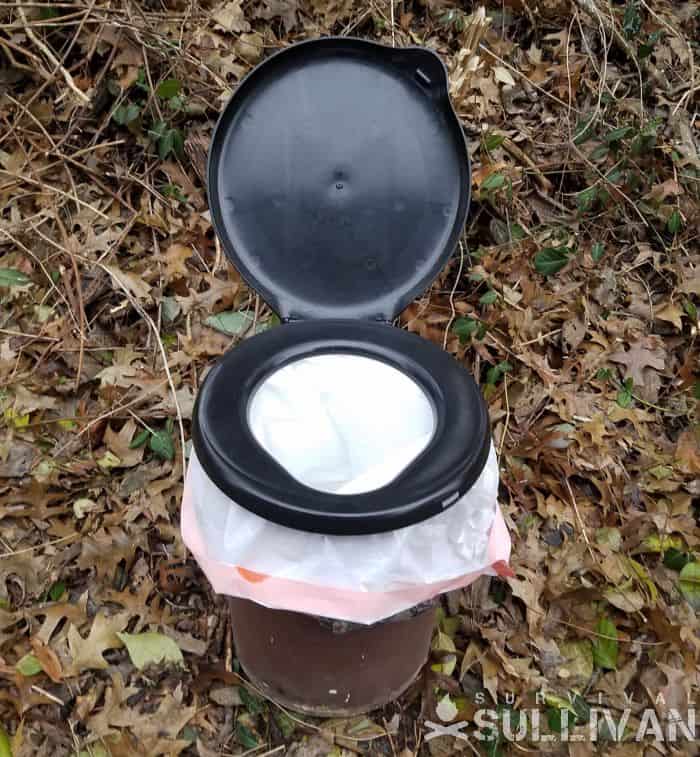
This choice may be taken away in a SHTF scenario and those that have prepared may be better equipped to bug in. Those that did not make any considerations with supplies or equipment will have a world of hurt thrown at their feet.
One thing is for sure, that within a few days that waste will start to build up. One person on average produces up to 3 pints of urine a day and one pound of poop. When you’re bugging in, here are some of our top tips and techniques for survival sanitation.
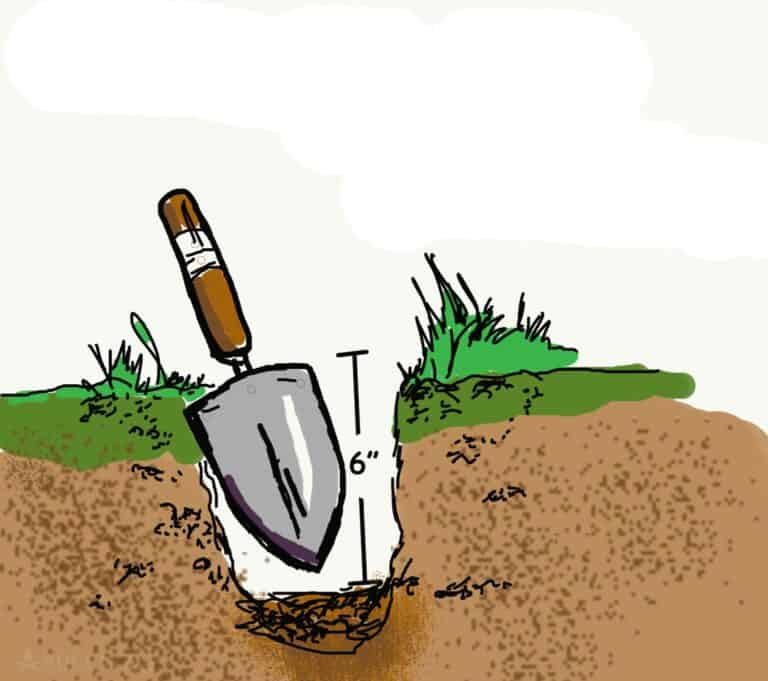
Table of Contents
Disposing of Urine
For most people, water is the most common way of eliminating urine. In a TEOTWAWKI world, water can become invaluable and you do not want to wash it away by the gallons just for urine removal.
For those who want to dispose of it, in a few days the ammonia will develop and become very strong. That’s the time to remove it. If you choose to dump it, remember it will kill any vegetation it touches.
Dumpit away from the living grounds, under the cover of night if you need to avoid announcing your presence. Be sure it’s over some gravel or in a cat hole (pictured), or one of the methods below.
Are There Any Benefits for Keeping Urine Rather than Dumping It?
There are quite a few uses for urine, so I would recommend collecting it and keeping it separate from any solid waste. A bucket with a tightly fitted lid would suffice for this for both the ladies and gents.
- Fertilizer Nutrient rich in phosphorus, potassium and nitrogen, urine makes a great fertilizer. E4C:source
- Generating energy A urine powered generator uses electrolysis to convert urine to fuel.
- Dental care The Romans used urine as a cure for bleeding gums and gingivitis.
- Vet care for animals The romans also used urine to cure sheep with bile and lung issues and sick bees. edu:source
- Compost latrines Researchers are simplifying compost latrines and encouraging rural countries to use them as a fertilizer generator for viable food sources. Some plant species especially love the compost produced, such as watercress and mushrooms. E4C:source
- Cleansing multi-agent After a few days ammonia develops in urine, and it’s in almost every cleaning prominent product out there as it is a degreaser, kills mildew and mold and lifts dirt.
- Sets dyes Europeans used it as a clothes brightener, but I like the way urine can set clothes dye. The Smithsonian claims the booming textile industry used about 1000 people’s pee per year when it was at its height.source
- Tanning and curing leather Urea and enzymes softens leather, while ammonia will be a good soak for leather to slough off hair and debris.
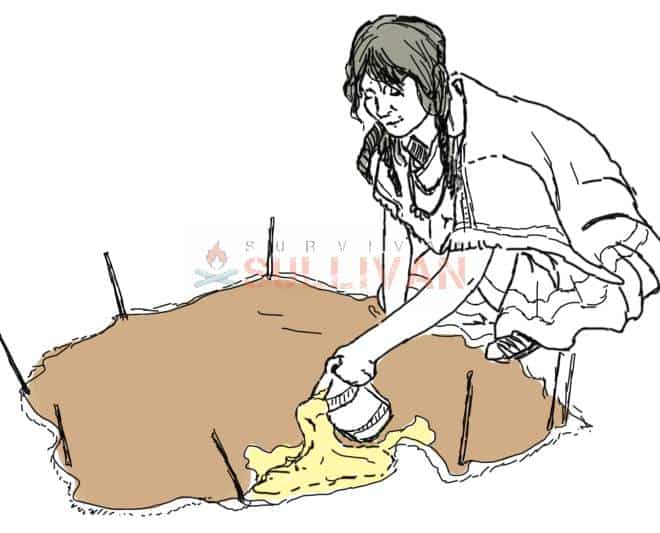
- Gun powder Until it was more readily available in the 1900’s; the nitrogen in urine was the source for the boom in gunpowder.
An astronaut did come up with a filtering method for turning pee and waste into water by osmosis (Salon: source), but its rather glitchy and has a lot of bulk waste with a need for high energy intakes, so it’s not on the list as a viable resource for preppers just yet.
Disposing of Feces
In many resources I see the repeated options on the many ways to throw feces out and for the preppers and survivalists who do not want to leave evidence of passing through, or who are our hunting or scavenging, it may be ideal to bury any waste.
If you choose to dispose of the human feces, the best way is to bury it, such as with a cat hole or using a 5 gallon bucket lined with some heavy duty plastic bags. This is also something you do not want to waste precious water on.
To keep the smell down in the bucket especially during the hotter months sprinkle a bit of quicklime over each fresh addition, adding dry materials will help. Shredded newspapers, mosses, dry grass, or you can use wood ash or sawdust after each visit to the bucket.
A touch of bleach will kill active bacteria and microorganisms and their multiplication efforts, and make sure any dangerous overflow isn’t a super-amoeba carrying some nasty transmittable infection with it.
Trash with blood and other bodily fluids can be disposed of with the refuse, and buried far away from the homestead (this includes tampons, wound wrappings, etc.) or used in special ways.
Slit Trench (Trench Latrine)
Compared to a cat hole, a slit trench is an outdoor toilet installation that can support many more people, or a smaller group for a much longer period of time.
They are much larger investment in terms of effort, manpower, and ultimately in maintenance when the time comes to fill them in or empty them, but if you know you’ll be staying in one place for the duration, it is best to get it over with, and start digging that slit trench.
If you are lucky enough to have power equipment, they can help you make short work of it.
A proper slit trench is at least a foot deep, preferably a little deeper around 16 to 24 inches, about four feet long and around 16 inches wide. There are two ways to afford stability to users of a slit trench that are easy enough to install in the field using rudimentary tools.
The first is a pair of heavy planks that are more than capable of supporting someone’s weight being placed on either side of the trench, straddling it.
The second is to create a rope that is used as a handhold, anchor between two posts running along the length of one side. This allows someone to squat, and hang over the slit trench.
Properly designed and appointed with stability aids, a slit trench is less messy, and requires only that someone scatter ash or lime over their leavings when they are done versus filling it in as with a cat hole.
Another feature you should consider installing around your slit trench is a privacy screen, easily made by hanging tarps for blankets overline strong for the purpose, or nailing it between simple posts to make an opaque enclosure.
This is definitely worthwhile considering a slit trench is designed to be used over a longer span of time. Laugh all you want; people desire privacy when doing their business!
Meet Your Poop
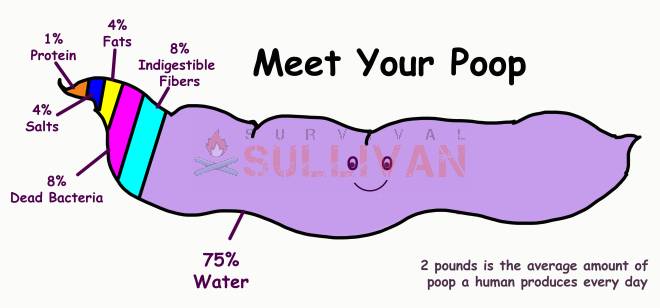
In reality, on thinking of a working homestead where resources are scarce and you need to be able to utilize everything that is produced in that self-sufficient and self-contained “ecosystem,” the smarter thing to do is use the feces for what it is: a readily available, self-sourced material aka biosolid.
Are there any benefits for keeping feces rather than dumping them?
Actually, it is smarter not to dump…well, the dump. That is, if you have the means and schedule built in where there isn’t a seriously overwhelming build up.
While many may wrinkle their nose at its use, composting the waste can be a bio-boost to your garden, as with any animal manure. There are many new developments in its uses that show what this black gold can do.
Here are some interesting examples of uses for human excrement:
- Fertilizer or “humanure”
Human poop is a bio-diverse and phosphorus rich form of energy that plants can use to easily convert into food.
Britain farms phosphate from feces and over 200 developing country farmers are using this method now as it’s a readily available resource in all countries, the global potential is amazing. Sciencedirect: source
- Fuel pellets and briquettes from human waste
The most useful application for recycling human feces is converting them into briquettes for fuel. I am not talking about compost or biogas, but actual burnable fuel as energy.
This is invaluable for bugging out and bugging in, and a Gates foundation grant is funding research into making a toilet that automatically does this, and available economically on a global scale. This could be a game changer in some counties!
- Biogas, SynGas, and hydrogen gas
It’s not quite affordable for the public yet, but machines using solar energy break down human excrement into usable gas energy.
Advanced humanure and urine in composting and crops from urine video:
Disposing of Animal Waste
This might seem like a no-brainer, but actually it can be dangerous to let too much manure from animals kept for food to accumulate.
E.coli, algae blooms, and salmonella can contaminate the groundwater from an overabundance of stockpiled animal manure. Manure also produces heat and can spontaneously ignite fouling the air over a large area.
In moderation, it’s life-giving and a necessity for any prepper or homesteader who is bugging in for a length of time to get a handle on its maintenance.
How much manure do animals produce?
- One cow that is lactating (in milk) can produce over 150 pounds per day
- One horse can poop every 2 hours, with an average of 3-5 pounds per poop
- One goat can poop up to 1 ton every year
- 20 chickens can produce over 4 pounds of guano a day
What Are the Benefits of Keeping Food Animal Waste?
The biggest reason to keep food animal waste is of course the beneficial nutrients as an additive to soil.
You can use it straight from the source, or compost it to make a living and nutrient dense organic matter that enriches the soils fertility by adding essential elements and microorganisms that break down the plant matter for consumption.
The way to use food animal and all grazing animals poop is to not use it when its super fresh, but wait until its decomposed down and drier and can be broken into an even topping for more flavorful and bountiful vegetables.
This method would also give your living compost pile a boost or be a plentiful source of nutrients for your worm composting bin.
The best animals for manure production are:
Birds that eats seeds may transfer weed seeds into the garden
Animal waste can be burned as fuel, and it has no smell when dry. When broken down it is a source of the biogas methane and can generate energy. SARE: source
Using dung as a fuel source is possible, but it involves extensive drying as manure is high in its moisture content. Cooking chips from cattle and grazing animals are used in lesser developed countries as fuel for the cooking fire due to their abundance and, but the heat of the flame is poor and low output.
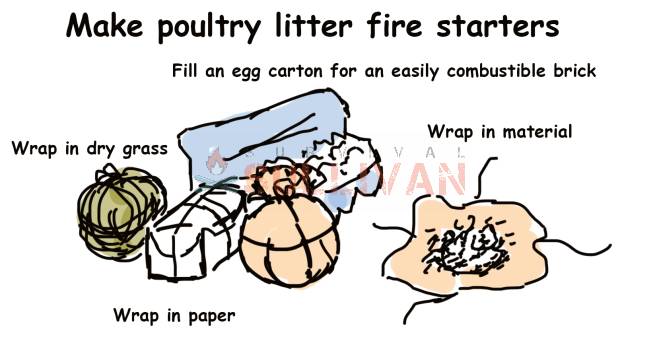
Use Poultry Litter to Make Fire Starter Bricks
Making fire starter packs from chicken and turkey litter has shown to be a promising survival method using “renewable energy”. The litter is a mix of droppings high in nitrogen, feathers, straw, bedding material, sawdust, and food and burns well due to its dryness.
Bundling litter tightly in cloth or paper, and tying with twine can be a good way to store some fire starter bricks. Just ignite the outer wrap material and you will have the start to a nicely fueled fire.
The official method of using turkey and poultry litter as a renewable energy source is called “pyrolysis.” Turkey litter is a “green energy” and facilities in England and Minnesota rely on it to fuel their electricity.
A video on how cow dung is converted to fuel and cooking gas:
Disposing of Pet Waste
Please take note: Unlike the food animal’s place on the farm with its manure providing a multiuse resource, your pet’s poop should be disposed of for a variety of reasons. Your pet’s waste is considered an environmental pollutant by the EPA along the lines of pesticides, herbicides and acid drainage!
Digging a latrine far away from the house and any water supply is the best method for disposing of your pets’ waste.
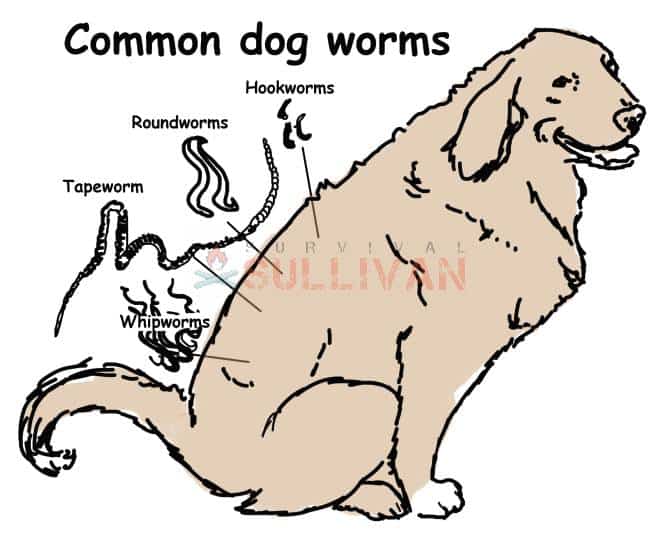
TAKE NOTE: I have seen many videos and articles that claim you can use a pet’s waste the same as any other animals and you can traditionally compost it along with human waste. It is NOT the same and should not be used on any food bearing plants or around food bearing animals.
Certain sites claim that you can use pet waste if it’s heated properly at over 140 degrees, but “heating may not kill all worms.” Studies are still “ongoing” on whether heating the pets poop will kill all roundworms.
Are there any benefits for keeping a pet’s waste rather than dumping them?
No, your pet’s naughty nuggets actually can contain 23 million fecal coliform bacteria in one solid gram that can live in the soil for YEARS according to the CDC.
Dangerous things that live in dog feces include:
- Worms: hook, round, whip, tape (human can get these), and pin (humans again)
- Corona
- Parvo (Doggie AIDSx 10, even if they live, their organs are severely compromised)
- Salmonellosis
- Zoonoses (humans can contract even when the pets are gone for years) resulting in diarrhea, stomach cramps, vomiting, achy muscles and high fevers
It is not manure by far, dog waste is the anti-manure as it actually feeds the weeds that choke gardens and crop producing plants, and promotes the growth of waterway algae which chokes the fish by decreasing oxygen in the water.
Dog poop and its effects on the environment video:
Disposing of Trash
As each person on average generates an estimated 1,589 pounds of trash per year, with the daily amount akin to 4 pounds per day, the buildup of trash can be real problem with any bugging in situation.
It doesn’t have to be if you employ a few smart techniques to help conquer it before it becomes an overwhelmingly stinky health hazard and the local critter buffet.
The disposal of trash starts with breaking it down. You will want to sort useable from actual trash that has no future use at all, to anyone. No one’s treasure. There probably won’t be much left after you have sorted it properly.
Breaking down the trash
- Compost You will want to take out anything organic for the compost pile.
- Metals From fishing lures to a conductor in an electrically charged makeshift alarm, pull out any metal for future use.
- Glass Bottles and glassware can be sterilized so this is a reason to keep them. A touch of bleach water will disinfect the surfaces. Glass can be boiled and sanitized. When heated with a lamp work torch or other small intense heat source, glass can be melded into new objects including vessels for storage.
- Paper Any paper waste can be broken down into a pulp and recycled to recreate new paper, toilet paper, fire starters, or oil blotters.
- Plastics Plastics can be bleached and wont rot, so these can be handy for seedlings, feeders for the animals, or mold materials for candy, soap, or pressed butters, etc.
What is left is best buried.
Burning Trash
Burning trash is another commonly employed method of disposal, used both here at home and abroad in situations where cleaner, but slower and more involved methods of waste disposal are not viable on a large-scale, or due to a lack of manpower or other resources.
Burning trash is in many ways the picture of simplicity: pile up your trash, take reasonable precautions against sparks for embers will not escape, add a squirt of accelerant, strike a match and then back up to watch the flames spew noxious smoke high into the air.
So burning trash is definitely convenient and it definitely works, reducing all but the sturdiest materials into charred ash and melted slag, but it does have some fairly obvious problems, namely the fact that the kinds of trash being burned (typically produced by people) will often release dangerous chemical particulates and fumes into the air.
Hazardous byproducts and VOC’s (volatile organic compounds) can be released when burning the following:
- Plastics
- Rubber
- Styrofoam
- Synthetic fabric
- Paint and other Coatings
- Petroleum distillates
- Liquid Fuels
All are capable of producing significant carcinogens when burned and can cause other illnesses besides.
To say these toxic fumes may create a major hazard for you and your group is an understatement.
One need only to look at the scandal created might a long-term burning of every kind of waste product in open pits that are military bases overseas and the subsequent disability and health afflictions inflicted upon the servicemen and women manning these pits to get a preview of what you might be facing if you turn to the burning of your trash long-term.
But it isn’t all bad, and with a little bit of care and ingenuity burning trash might be an effective way to dispose of certain types of waste and also create some warmth and light in the bargain. Generally speaking you can safely and regularly burn:
- Paper products
- Cardboard
- Natural cloth
- Dried fecal matter
All will burn readily and well, and can even be used with a modicum of safety as a fire for both light and warmth.
Anytime you are planning on burning garbage, make sure you follow all precautions but you would normally for a fire, and burning your garbage in a pit, a burn barrel (if you’re bugging in), or depression is a good idea.
Keep in mind that the average adult human generates several pounds of garbage every single day, and the average American generates just a little bit shy of a short ton worth of garbage every single year.
If you are planning on burning all of the garbage you generate, that will result in regular, smaller garbage burns or fewer massive bonfires of flaming garbage.
Dealing With Waste When Bugging In
The principles of managing waste are very much the same when bugging in as when bugging out, only the pressure will really be on to securely contain, store and dispose of all your leavings.
Any failure to follow proper procedures will result in absolutely intolerable living conditions, and very likely an outbreak of disease that will burn through a group of people living in close quarters in no time flat.
In the following subsections I will tell you what you need to know about waste generation concerns while bugging in as well as several tried-and-true methods for doing your business even when the water and sewer infrastructure is no longer functional.
Waste by the Numbers
If you have made it through the article this far already I’m going to assume you are not particularly grossed out or squeamish, but I still warn you that what I’m about to share with you might set your skin to crawling. You have been warned!
We are talking about the raw and nasty numbers of feces and urine, and just how quickly the amount that you and other adults generate can get out of hand while bugging in.
On average a healthy adult human will drop anywhere from 3/4 of a pound to one whole pound of poop every, single day. That same adult human will tinkle out anywhere from 2 to 3 pints of urine, perhaps even a little bit more if they are staying hydrated.
Now, you do the arithmetic: Let’s say you have four people, adults that is, living in the same building at the same time. Let us also say that the toilet does not work or is not trustworthy.
Every, single day, you will have 4 pounds of human poop, and over one gallon of urine to deal with. That’s pretty gross!
But it gets grosser still: What would you do if you had to deal with that, and you had no way to safely leave the confines of your shelter? If your heart is racing, you are not alone! Try to keep up. Things are going to get absolutely disgusting, positively wretched and incredibly odorous very quickly.
But that isn’t the worst of it. The worst of it is what will happen when flies, other insects and even mammals get a whiff of your sweet and delicious leavings and start making a beeline for it.
Any creature that touches the waste, including your faithful dog, Fido, and your beloved cat, Fluffy, are now vectors for whatever harmful pathogens are residing in that waste.
Wherever their paws and mouths go so to do the germs. Your face, your hands, your food, your blankets, everywhere.
As you might expect, the outbreak of disease will be nothing short of cataclysmic for you and your group. It might be the straw that breaks the camel’s back if you’re living in the middle of an SHTF situation. It could very well spell your doom.
Back to reality: that is just the waste left from a single day. How do you think a week will turn out? How do you think a month will turn out?
It is best not to think about it, but it is best to prepare for that eventuality because that is going to be your reality after a major disaster. I’m happy to report that dealing with this nasty and smelly eventuality does not have to be difficult if you pay attention to what I’m going to teach you next.
Improvised Toilets for Bugging In
When the time comes, and come it will, to deal with your waste and the waste of your group during a survival situation while bugging in you had better be prepared, both for disposal and for storage. What’s the difference?
Waste disposal is what you do when you actually go to the bathroom. Your body is disposing of waste, and hopefully you don’t have to drop your trousers and go in the bathtub!
Waste storage on the other hand is a more or less semi-permanent container that will hold accumulated leavings until they can be properly gotten rid of permanently when time and opportunity permit.
Below are a couple of options for bug in waste disposal. These are improvised indoor toilets, for lack of a better term. Despite being improvised they are effective, easy to implement and even pretty comfortable to use.
But as always the number one thing you can do to greatly improve the quality of your “go” is to have a big, beautiful and bountiful stash of genuine toilet paper on hand. There are lots of other things you can use, but toilet paper is highly sanitary and also great for morale so make sure you keep a ton of it in stock.
If you didn’t stock up on toilet paper, ran out or had it stolen in the Charmin Wars of 2032 you might consider using the following improvised butt-wiping appliances:
- Leaves – Plant leaves work great so long as they have the right thickness and texture. You can always double up to be sure your fingers don’t bust through and you get dookie under your fingernails. Be triple sure you are not using irritating or poisonous plant leaves for this purpose!
- Newspaper – Not as common today as they used to be, newspaper still makes a pretty good improvised toilet paper. Try to avoid pages that have pictures on them as they often have a greasy feel. You can crinkle them up and smooth them out multiple times to make them softer.
- Book Paper – Similar to using toilet paper, some books are so terrible they are destined only for this purpose. Handy because they are in a convenient format that has pre-sized pieces ready for tearing out. Don’t forget to crumple them up and smooth them out a few times to soften them.
- Rags/Cloth – You can use old rags, socks, pieces of t-shirt, old drapes virtually any kind of fabric as an effective toilet paper. Cloth used for this purpose will either have to be thrown away or extensively and carefully laundered and disinfected before they can be used again for any purpose. On second thought, if you do clean them keep them dedicated just for toilet duty.
Next up are a couple of options for utilizing an improvised indoor toilet.
Bucket Toilet
Every prepper knows and loves those ubiquitous, brightly colored 5-gallon paint buckets you can get from absolutely every hardware store on earth. They have a million and one uses, and this might very well be their number one use if your toilet is out of order. Know what I mean?
The concept is simple: All you need to do is line one of these buckets with two, yes two, heavy-duty can liners or some other plastic bag that will not leak.
Then all you have to do is fill the bottom of the exposed bag with some kind of odor and wetness absorbing media, be it sawdust, wood ash, kitty litter or even crumbled and shredded newspaper. Bonus points if you have stocked some RV chemical toilet additive.
Next you’ll need a seat. Believe it or not there are purpose-made attachable seats for these buckets that feel just like your toilet seat in your bathroom that snap right on to the rim.
These are nice but not totally necessary. In a pinch, you can create an improvised seat from all kinds of things, but a pair of smooth boards on either side will work well enough and be comfortable.
Do your business as usual when nature calls, and when you are done you can seal the bucket using a heavy, gasketed lid that is usually sold with or near the buckets. This will go a long way towards keeping odor down.
Be cautious that you do not let the bag get too full! Before it gets way too full for comfort, remove the outer bag, tie it up and then take it to your waste storage site, which might just be an even larger sealing trash can.
Take pains to keep this toilet clean and odor down by squirting it with powerful disinfectant or a strong solution of bleach and water between uses. If you have been building fires, keep some of the coals and ash as you can use that as a disinfectant and odor remover, too.
Composting Toilets
You have probably heard of compost toilets for use in RVs and other compact living settings since they have no real plumbing requirements, and take up less space than a comparable water flush toilet and attendant piping.
A compost toilet is exactly what it says on the tin: your waste products, both fecal matter and urine, going to separate bins we’re a composting medium will help them break down into essentially fertilizer.
Modern compost toilets definitely work and can be highly efficient, with sealing mechanisms and even limited water flush capability that helps keep them clean and keep odors down.
Some models utilize electrically powered fans to help move odors and stench out of their waste containers to further help keep older down inside your bathroom. These obviously will no longer work should you lose power in the middle of an emergency situation.
While the experience of using a compost toilet for your daily movements is identical for using a conventional water flush toilet there are some extra steps to maintaining a compost toilet system, namely turning over the contents of the storage container periodically using a crank tumbler mechanism.
Once full or after a certain amount of time passes to allow the waste to break down, the container is empty and the contents can be disposed of or repurposed.
Composting toilets are an excellent idea for homesteaders and permaculturalists, using as they do little or even no water and turning waste into a useful product for your property. Their lack of dependency upon public utilities and other infrastructure also makes them a good choice for preppers.
Assuming you aren’t too squeamish about dealing with the contents of the waste container, and will commit to maintaining the system appropriately these toilets are a great way to bolster your self-sufficiency.
Flush Toilet
If you just did a double-take, hear me out! I know the reason this article exists is because you fear not having access to normal toilets when bugging out or bugging in, but despite this fear and preparation there are times where your standard, built-in toilet will remain functional even if water is no longer running to your house.
I will tell you what to do to keep using it, but first a couple of caveats.
First, you must be absolutely, positively sure or at least as sure as you can be that your local sewer mains are not broken and spilling waste all over the place because you are just going to contribute to the problem and make it worse, potentially poisoning everybody around when that sewage reaches groundwater sources.
The second problem is that you will have to manually supply water to the toilet cistern in order to provide pressure for flushing. Depending upon the situation you are dealing with this could be either a trivial or a grievous waste of a precious resource. I won’t tell you which is right, but I am telling you to choose carefully.
All you’ll need to do is load the bowl with a normal amount of water (look for the mineral deposit ring in the finish if you need a guide) and then load the cistern up until it is level or just below the level of the overflow pipe.
Do your business as usual, then flush normally and breathe a sigh of relief as your leavings are washed out of the bowl and into the sewer.
On Septic Systems
If you are not connected to city water and sewer supplies, you are likely going to be in a much better place during a major emergency then someone who is.
As long as you can still source water one way or another to feed your toilet bowls, you can keep right on doing your business and flushing like normal, secure in the knowledge it all of your waste and grey water is heading to your septic tank and not into a sewer main that may or may not be broken.
In fact the biggest problem for people who are on well water that rely on septic systems is the fact that your well pump is probably going to lose power if you do not have your own backup power infrastructure.
In that case, start thinking ahead now and figuring out where you can source ample water from that is suitable for loading your toilet bowls and cisterns with.
This could be from a pool, a nearby pond or stream, or from some other source that is not necessarily ready for drinking straight away, but could work just fine for the purpose.
Septic systems are expensive to install and maintain, and you won’t have to look far to find someone who can regale you with some horror story about the time when they’re septic system malfunctioned, but they are a great way to increase your independence and to prevent disaster when city sewer and water lines are shut down or break in the aftermath of a major event.
Sanitation and Waste Disposal Supplies for Bugging In
If you are wise, you will not have to rely on much improvised material to handle your sanitation and waste storage needs during a disaster.
Make sure you add the following items to your survival stash, and do so in abundance so you will be prepared for the worst eventualities when bugging in. It will help keep you safe, but also help make you and everyone else far more comfortable than they would be otherwise:
Waste Disposal and Storage
- Contractor Bags, heavy mil
- Can liners, heavy mil
- Gallon Freezer bags
- Disposable Gloves
- Chemical-resistant gloves w/ gauntlets
Toilet and Improvised Toilet Supplies
- Toilet paper (Don’t skimp!)
- 5 gallon buckets w/ gasketed lids
- Composting toilet (optional)
Cleaners, Soaps and Other
- Hand Soap
- Liquid Soap
- Rags
- Disinfectant, concentrated (save space and dilute with water)
- Bleach (vital for killing germs and decontamination)
Wrap Up
One crucial thing that will come into play to keep everyone healthy and the homestead functioning at an optimum production level is the proper elimination of sanitation. For the unprepared, this will not be as important at first when SHTF.
For the prepared, survival sanitation will be a daily drill in efficiency that the whole family will need to play an active part in for a clean environment and disease free self-containment.
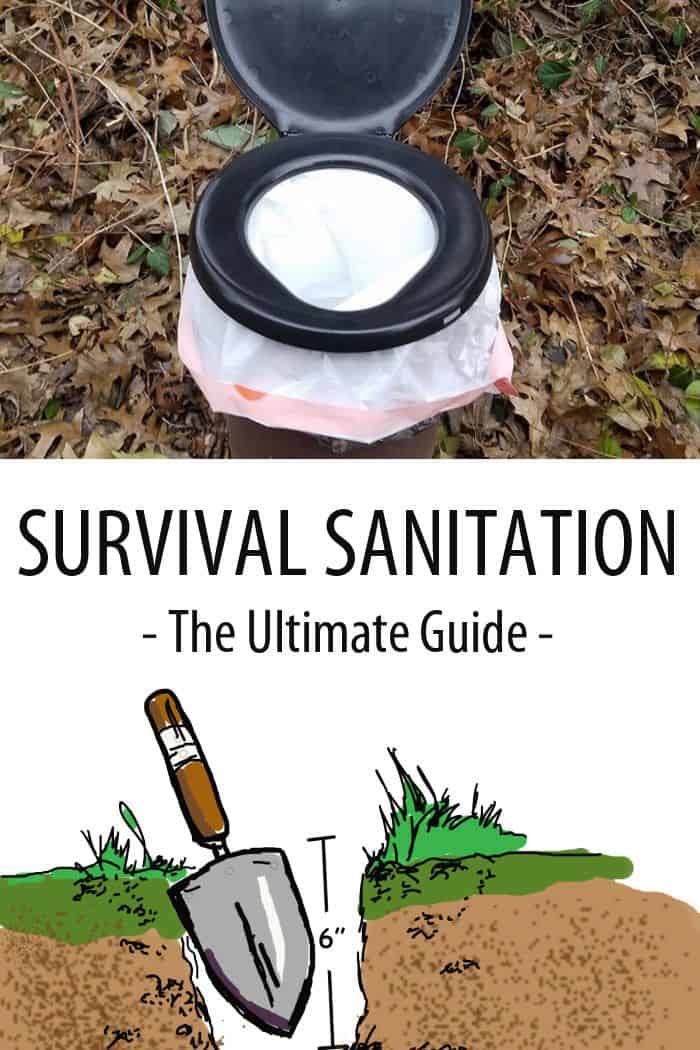
updated 10/06/2020

Growing up in the Bluegrass State, it was a point of familial pride to be able to shoot, trap, identify plants and track animals. Summer camps helped us be well versed in camping, weapons, and survival skills from a young age. We were surrounded by such a lush environment, and we used the resources we had.
I met my soulmate in my happiest place to be- a seemingly enchanted winding trail next to a beautiful wooded glen- where I spent as much time exploring as I could during daylight hours with my trusty four-legged friends.
The bucket list includes living the days painting and writing on a fully self-sufficient homestead, off-grid with our animals and family and plenty of land for the significant other (who I think is a true artist at weapons and living that way) to shoot to his heart’s content. Naturally organic living for us and the animals is a goal.

A urine generator perked my interest, so I investigated it. It appears to be an internet myth and does not really exist.
Well, the ones used in India and in Nigerian school sciences fairs I think proved to be hoaxes, or not quite legit or as simple as shown.
But the ones not straight from pee, but convert urea to hydrogen then energy are real:
– “The process has been patented. It is a low energy electrolysis process that converts ammonia and urea in waste water to hydrogen, nitrogen and pure water. The electric current in the device creates an electrochemical reaction that oxidizes urea and turns it into carbon dioxide which is then moved into the electrolyte material in the machine. This technology was developed by Professor Gerardine Botte, a chemical engineer at Ohio University.
What these kids are doing is taking urea electrolysis and making hydrogen and then using that hydrogen to make electricity – Gerardine Botte”
there are also ones that use the microbes in waste and convert that, but very expensive. I am doing an articles on these separately and this is from the source materials :
estimates that if a one-cubic-metre box containing a microbial fuel cell system was installed in a village of 2,500 people – and all their urine was constantly funnelled through that box – you could generate a constant current of around 500 watts. This would equal around 12 kilowatt hours of energy per day, or enough to run only one standard 50-watt bulb for around 240 hours.
Presently, this kind of system would cost between $5,000-$10,000. While that’s a hefty price tag, it would last for an incredibly long time, says Rabaey, “because these organisms inside are self-renewing. As long as you feed it waste water, the bacteria is happy.”
I will be sure to make the distinction that its hydrogen or microbes converted from the urine, they ultimately use, not straight urine as you are so right- I saw a LOT of generators or things they said can be used from straight from the natural source, and thats not correct. It has to be converted.
Thanks so much for commenting and being a reader!!!
Dyann
Current is amps….watts = volts X amps
If you live in the frozen Northland and haven’t gave extra thought to the wintertime sanitation problems – prep for problem ….
Id like to hear more of your thoughts, please let us know some concerns in northern winters.
“Take pains to keep this toilet clean and odor down by squirting it with powerful disinfectant or a strong solution of bleach and water between uses.”
You should NEVER use bleach in your makeshift toilet!
Bleach is chlorine when mixed with ammonia (as is in urine) it creates deadly chloramine/chlorine gas.
Treating your bucket in such a way that it has ample dry coating and emptying it daily/weekly should help, being sure it is kept in an “outhouse” for use would be better, and ALWAYS ALWAYS ALWAYS wash your hands when finished in the bathroom.
If you feel the need to “wash” out your bucket, you would do much better to use soapy water.